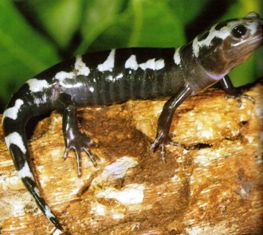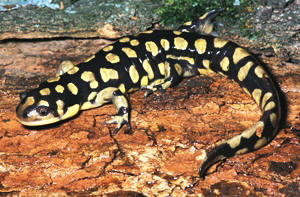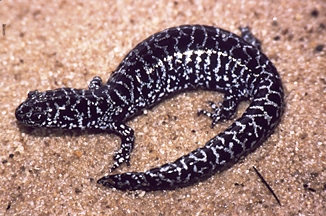Discover Florida Nature
It's time to explore the natural Florida


|
|
|
|
|
Salamanders are amphibians that have long tails and moist skin. All
salamanders must keep their skin moist because it is comparatively soft
and does not protect them against loss of moisture. For this reason they
require damp environments. Even the land species are usually found in
shady, wooded areas near water. Some burrow into damp ground. With the
exception of sirens and amphiumas, salamanders look basically like
scaleless lizards. Southern people often call salamanders "spring
lizards" because they are often seen near springs. But unlike lizards,
salamanders have neither claws, nor scales, and their legs are so short
that their bellies drag on the ground. Being amphibians, most
salamanders undergo metamorphosis. Unlike frogs salamanders don't lose
their tails when they change from the larval stage to adults. What would
be called the tadpole stage in frogs is called the larval stage in
salamanders. Salamanders can regenerate limbs as well as tails and can
even regenerate eye retinas and severed optic nerves. Marbled
Salamander- Adult marbled salamanders live in damp woodlands,
often close to ponds or streams. These salamanders are occasionally can
be found around dry hillsides, but never far from a moist environment.
The marbled salamander ranges in size from about 3 to 5 inches in total
length. The ground color is black, and there are numerous silver-white
crossbands, giving the marbled appearance for which the species is
named. There is considerable variation in the crossbanding pattern, as
in some individuals they are extensively connected, and in others the
connection is minimal. The nesting female typically curls herself
around the eggs while waiting for rain to fill nest cavity. The larvae
usually hatch a few days after inundation. If autumn rains are scant,
eggs may not hatch until spring. Marbled
Salamander- Adult marbled salamanders live in damp woodlands,
often close to ponds or streams. These salamanders are occasionally can
be found around dry hillsides, but never far from a moist environment.
The marbled salamander ranges in size from about 3 to 5 inches in total
length. The ground color is black, and there are numerous silver-white
crossbands, giving the marbled appearance for which the species is
named. There is considerable variation in the crossbanding pattern, as
in some individuals they are extensively connected, and in others the
connection is minimal. The nesting female typically curls herself
around the eggs while waiting for rain to fill nest cavity. The larvae
usually hatch a few days after inundation. If autumn rains are scant,
eggs may not hatch until spring. Mole
Salamander- The mole salamander, Ambystoma talpoideum,
is fairly common in Florida. Adults are nondescript, usually having a
fairly uniform ground color that ranges from a muted bluish-gray to
nearly black. Mole salamanders rarely get larger than 4.5 inches in
total length. The mole salamander is a stout species with a broad
depressed head. The head and feet seem too big for the body. the mole
salamander burrows but is often found under logs and in other damp
places. Mole salamanders will gather in temporary ponds in early spring
to reproduce. Mole
Salamander- The mole salamander, Ambystoma talpoideum,
is fairly common in Florida. Adults are nondescript, usually having a
fairly uniform ground color that ranges from a muted bluish-gray to
nearly black. Mole salamanders rarely get larger than 4.5 inches in
total length. The mole salamander is a stout species with a broad
depressed head. The head and feet seem too big for the body. the mole
salamander burrows but is often found under logs and in other damp
places. Mole salamanders will gather in temporary ponds in early spring
to reproduce. Eastern
Tiger Salamander- The tiger salamander is one of the largest
terrestrial salamanders in the United States. The biggest specimen
recorded was 13 inches long. The average size ranges between seven and
eight inches. It is stocky with sturdy limbs and a long tail. The body
color is dark brown, almost black, and irregularly marked with yellow to
olive colored blotches. The only other salamander with which it might be
confused is the smaller spotted salamander. The spotted, however, has
two rows of regular, yellow-to-orange spots running parallel down its
back, as distinct from the irregularly distributed spots of the tiger
salamander. The tiger salamander spends most of its life underground, as
do other members of the group referred to as "mole salamanders." The
eastern tiger salamander ranges along the east coast from southern New
York to northern Florida, west from Ohio to Minnesota and southward
through eastern Texas to the Gulf. . It takes four to five years for the
salamanders to reach sexual maturity and they may live for 12-15 years.
The tiger salamander eats invertebrates and small vertebrates. Eastern
Tiger Salamander- The tiger salamander is one of the largest
terrestrial salamanders in the United States. The biggest specimen
recorded was 13 inches long. The average size ranges between seven and
eight inches. It is stocky with sturdy limbs and a long tail. The body
color is dark brown, almost black, and irregularly marked with yellow to
olive colored blotches. The only other salamander with which it might be
confused is the smaller spotted salamander. The spotted, however, has
two rows of regular, yellow-to-orange spots running parallel down its
back, as distinct from the irregularly distributed spots of the tiger
salamander. The tiger salamander spends most of its life underground, as
do other members of the group referred to as "mole salamanders." The
eastern tiger salamander ranges along the east coast from southern New
York to northern Florida, west from Ohio to Minnesota and southward
through eastern Texas to the Gulf. . It takes four to five years for the
salamanders to reach sexual maturity and they may live for 12-15 years.
The tiger salamander eats invertebrates and small vertebrates. Flatwoods
Salamander- The flatwoods salamander is medium-sized, reaching
an adult length of 5 inches (13 centimeters). Body color ranges from
silvery gray to black, with the back heavily mottled with a variable
gray cross-band pattern. The underside is plain gray with faint creamy
blotches. The head is small and equal to the neck in diameter. The
flatwoods salamander used to crawl over 100 million acres of longleaf
pine habitat in the Southeastern United States. Now there is less than 3
million acres of habitat left . The best
time to flatwoods salamanders are at night, when they come out for food.
They are solitary creatures who live alone and spend most of the
daylight hours in underground burrows or in cool, damp crevices under
rocks or logs. They have fragile bodies and should be handled as little
as possible. Flatwoods
Salamander- The flatwoods salamander is medium-sized, reaching
an adult length of 5 inches (13 centimeters). Body color ranges from
silvery gray to black, with the back heavily mottled with a variable
gray cross-band pattern. The underside is plain gray with faint creamy
blotches. The head is small and equal to the neck in diameter. The
flatwoods salamander used to crawl over 100 million acres of longleaf
pine habitat in the Southeastern United States. Now there is less than 3
million acres of habitat left . The best
time to flatwoods salamanders are at night, when they come out for food.
They are solitary creatures who live alone and spend most of the
daylight hours in underground burrows or in cool, damp crevices under
rocks or logs. They have fragile bodies and should be handled as little
as possible. |
|
|
Advertise | Privacy Statement | Dog Encyclopedia | Video |Contact | Alaska Nature |
|